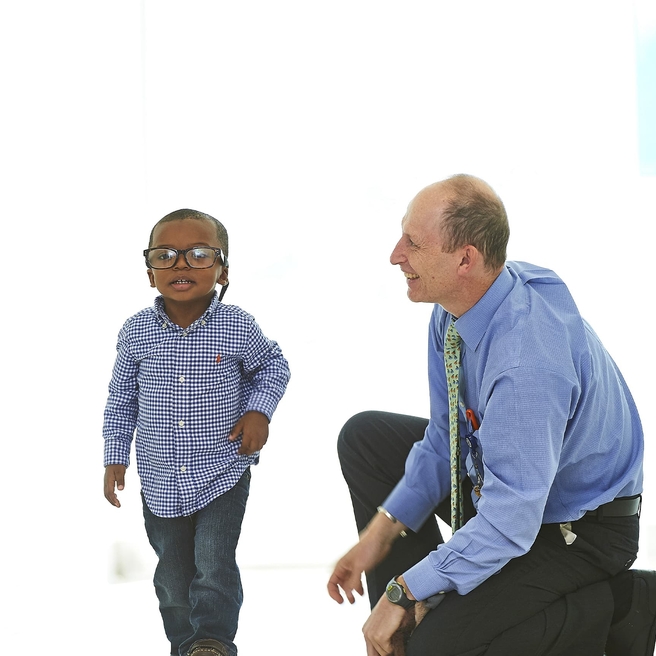What is amblyopia?
Amblyopia, also known as lazy eye or wandering eye, is a common vision problem in children. In most cases of amblyopia, your child’s brain ignores the signals coming from one eye, meaning the other eye is the only one being used.
Over time, the brain gets used to working with only one eye. The eye that’s being ignored by the brain doesn’t develop normal vision.
If treated while your child is young and the eyes are still developing, he has a good chance of overcoming amblyopia. The goal of treatment is to make your child’s brain use both eyes. Getting the eyes to work as a team becomes harder as your child grows. Early treatment is best; and treatment may not work at all if started after 7-10 years of age.
If left untreated, amblyopia may keep your child from developing normal vision.
Amblyopia affects 2-5 percent of children.
Causes
Amblyopia has three main causes:
- Strabismus, which occurs when a child’s eyes aren’t aligned (straight). The eyes don’t work together. This leads the brain to ignore one eye.
- Refractive error, or need for glasses. Children are especially at risk if one eye has larger need for glasses compared to other eye.
- Conditions that cause poor vision in one eye, like cataract or droopy eyelid (ptosis), which prompts the brain to ignore the blurry pictures seen by that eye.
Additional factors can place a child at a higher risk for amblyopia, including:
- A family history of amblyopia
- Prematurity
- Developmental delay
- Craniofacial disorders
- Certain genetic conditions, such as Down syndrome (trisomy 21), 22q deletion syndrome, Williams syndrome and Noonan syndrome
Symptoms
Symptoms of amblyopia can vary from child to child, but may include:
- Squinting in one or both eyes
- Rubbing one eye (not just when tired)
- Holding items close to the eyes to see them
- A wandering or crossed eye (strabismus)
It’s important to note that some children display no symptoms of amblyopia. The child’s strong eye — and her brain — can compensate for the weaker eye, making it appear that the child has good vision.
Testing and diagnosis
Vision screening is the best way to detect presence of amblyopia or risk factors for developing amblyopia. Photoscreening, a type of vision screening that uses a special camera to determine how well a child can see, is often performed in conjunction with vision testing at pediatricians or schools.
Treatments
The goal of treatment for amblyopia is to:
- Correct the problem that is causing amblyopia
- Make each eye see as well as it can, which often involves forcing the brain to use the “weak” eye
- Force the brain to use the signals from both eyes
- Make both eyes work together
Amblyopia is most often treated by blocking one eye to keep it from doing all the work. The brain can learn to accept signals from the eye that’s being ignored. Gradually, vision in this eye may improve.
Commonly used treatments include:
- An eye patch is placed over the eye that’s being used. With this eye blocked, the brain is forced to start working with the eye it’s ignoring. The patch must be worn while your child is awake. Your child may not like wearing a patch. But remember that treatment will work only if your child wears the patch as often as instructed.
- Medicated (atropine) eye drops can be used instead of a patch. Drops are put in the “good” eye, blurring near vision in that eye. This allows the eye that’s being ignored to start working with the brain. Eye drops may be an option for certain children who don’t like wearing a patch. But putting in eye drops can take practice.
- Eyeglasses can help correct focusing problems. They can also be prescribed to blur sight in the eye that’s being used. This forces the brain to work with the eye it’s ignoring. In some cases, sight in one eye is blocked by sticking a patch or a filter to the inside of an eyeglass lens. As vision improves, your child’s eyeglass prescription may change.
Follow-up care
Once amblyopia improves, maintenance treatment may be needed to prevent vision from slipping. Maintenance treatment includes continued wearing of eyeglasses and/or wearing an eye patch for decreasing amounts of time during the day than was required during the treatment period.
Outlook
Amblyopia can cause blindness, but fortunately it is the most reversible cause of blindness. Treatment is highly successful as long as children and families stick to the treatment plan.
Resources to help
Division of Ophthalmology Resources
We have collected helpful resources on pediatric eye care so you can feel confident in the care you're providing your child.
Reviewed by Stephanie M. Davidson, MD
